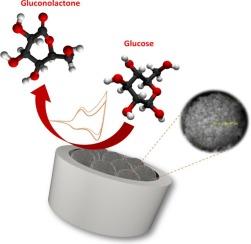Glycerate-assisted CoMn-sulfide with microsphere architecture confined by nanoparticles as an efficient enzyme-free sensor for amperometric measurement of glucose in serum, saliva and beverage samples
IF 8.5
1区 农林科学
Q1 CHEMISTRY, APPLIED
引用次数: 0
Abstract
The preparation of binary metal chalcogenides with ideal architectures can effectively enhance the electrocatalytic properties of these materials, as promising glucose sensors. Herein, CoMn-S spheres were synthesized using CoMn-glycerate as the precursor, followed by a sulfidation reaction. First, glycerate spheres were prepared by solvothermal treatment of Co and Mn ions in isopropanol solvent mixed with glycerol. Then, CoMn-glycerate was solvothermally sulfidized using an ion-exchange process to prepare glycerate-assisted CoMn-S spheres with many nanoparticles on their surface which provide abundant electrocatalyst sites. The sensing outcomes revealed that glycerate-assisted CoMn-S spheres have impressive electroanalytical performance with high sensitivities of 5148 and 1928 μA mM−1 cm−2 in broad measuring ranges of 0.001–0.63 mM and 0.63–2.53 mM, quick response to glucose oxidation (2 s), and a low detection limit of (0.88 μM). Furthermore, the sensor has been successfully employed to measure glucose in human serum, saliva, and beverage samples such as fruit juice, milk, and soft drinks with satisfactory recoveries. The high electrocatalytic activity of the CoMn-S sphere sensor results from the synergy between the components and nanoparticle-assembled microspheres, which creates a high surface area, shortens the charge transfer routes, and improves the electro-conductivity. The performance characteristics of the glycerate-assisted CoMn-S spheres were compared with CoMn-hydroxide needles and CoMn-S sheets. The glycerate-derived design provides an efficient and effective strategy to construct the enzyme-free platforms with high assay capability.


甘油酸盐辅助的硫化钴锰(CoMn-sulfide),具有纳米颗粒限制的微球结构,是一种高效的无酶传感器,可用于血清、唾液和饮料样品中葡萄糖的安培计测量
制备具有理想结构的二元金属卤化物可有效提高这些材料的电催化性能,从而成为前景广阔的葡萄糖传感器。本文以 CoMn-甘油酸盐为前驱体,通过硫化反应合成了 CoMn-S 球体。首先,在与甘油混合的异丙醇溶剂中对钴和锰离子进行溶解热处理,制备出甘油酸钴锰球。然后,利用离子交换过程对 CoMn 甘油酸盐进行溶解热硫化,制备出甘油酸盐辅助的 CoMn-S 球体,其表面有许多纳米颗粒,提供了丰富的电催化剂位点。传感结果表明,甘油酸盐辅助 CoMn-S 球体具有令人印象深刻的电分析性能,在 0.001-0.63 mM 和 0.63-2.53 mM 的宽测量范围内,灵敏度分别高达 5148 和 1928 μA mM-1 cm-2,对葡萄糖氧化反应迅速(2 秒),检测限低(0.88 μM)。此外,该传感器已成功用于测量人体血清、唾液以及果汁、牛奶和软饮料等饮料样品中的葡萄糖,回收率令人满意。CoMn-S 球形传感器的高电催化活性源于各组分与纳米粒子组装的微球之间的协同作用,这种协同作用产生了高表面积,缩短了电荷转移路径,提高了电导率。将甘油酸盐辅助的 CoMn-S 球与氢氧化钴锰针和 CoMn-S 片的性能特征进行了比较。甘油酯衍生设计为构建具有高检测能力的无酶平台提供了一种高效、有效的策略。
本文章由计算机程序翻译,如有差异,请以英文原文为准。
求助全文
约1分钟内获得全文
求助全文
来源期刊

Food Chemistry
工程技术-食品科技
CiteScore
16.30
自引率
10.20%
发文量
3130
审稿时长
122 days
期刊介绍:
Food Chemistry publishes original research papers dealing with the advancement of the chemistry and biochemistry of foods or the analytical methods/ approach used. All papers should focus on the novelty of the research carried out.
 求助内容:
求助内容: 应助结果提醒方式:
应助结果提醒方式:


